
Spider monkeys, Superb acrobats of the forest
You may have heard of varieties of spiders and monkeys, but spider
monkeys? Perhaps not. Considered to be more primitive than the old world
monkeys, these slender-bodied primates are found in tropical forests,
semi-deciduous and mangrove forests, from southern Mexico to Brazil.
They are indeed very fascinating creatures, so let's find out what they
are like ...
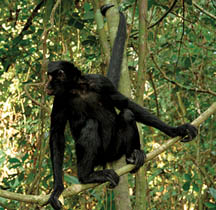
Second only to gibbons (the lesser apes) in their agility, spider
monkeys are famous for their acrobatic movements, especially the swift,
tremendous leaps they make from one tree to another. In fact, it is
these long acrobatic leaps they make with their long limbs and tails
sprawling out like those of a spider's, that has resulted in them being
called 'spider monkeys' and also earned them the title 'acrobats of the
forest'.
Appearance
Their bodies are not in proportion at all. These spider monkeys have
long limbs with hook-like narrow thumbless hands, elongated and
re-curved fingers and slender bodies with long tails reaching up to 89
cm which are sometimes longer than their bodies.
The prehensile (capable of grasping) tail which is muscular and
tactile (relating to the sense of touch) is used as an extra hand when
climbing and gripping. These flexible tails, which are hairless at the
tip, have skin grooves similar to fingerprints. When hanging by the
tail, the spider monkeys have their hands free to forage (make roving
search) for food.
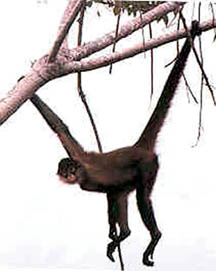
These monkeys have coarse hair which is ruddy gold to brown in colour.
The heads are small, nostrils are set wide apart and the faces are
hairless. Some species have white chin whiskers and coloured rings round
their eyes. The hands and feet are generally black.
The body length of adult spider monkeys who are generally larger than
the females are about 15-26 inches (head and body), tail 20 to 35
inches, and the weight around 12-16 lbs (6-8 kg). Muzzle is prominent.
Locomotion
Spider monkeys rarely come down to the ground, and live mostly in the
upper canopy of trees in the forests, jumping from branch to branch and
tree to tree.
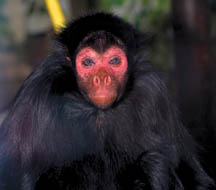
They use many ways to get from one place to another. When walking or
running, they are quadrupedal (use all four limbs). When hanging,
climbing or moving from tree to tree they usually use the suspensory
method, and then they become bipedal (using only two limbs) when
leaping.
Even when they are on the lookout for enemies or any danger, they
usually walk on two feet, using the tail as support. They cover up to 40
feet, swinging from branch to branch on arm strides.
Species

It is believed that there are more than four basic species, even
though some argue it is strictly four species. Anyway, these monkeys are
classified according to the regions they live in and their physical
differences.
The Black-handed or Geoffry's Spider Monkey, which is the least
endangered, is either black, brown, silver or rust in colour. Then,
there are the Red-faced spider monkey, White-fronted spider monkey,
Brown-headed spider monkey, White-cheeked spider monkey, Black-headed
spider monkey, Brown spider monkey and Hooded spider monkey.
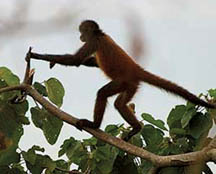
Apart from the above mentioned, there are Mexican spider monkeys,
Peruvian spider monkeys, Colombian spider monkeys and Yuctan spider
monkeys. Three species of these monkeys are considered to be endangered.
Their diet...
Spider monkeys are frugivorous, meaning 90 per cent of their diet
consists of fruits and seeds. As they eat the mature, soft parts of a
wide variety of food, the seeds too are swallowed along with these
fruits.
Apart from fruits, the spider monkeys also sometimes eat the barks of
trees and also decaying wood, leaves, flowers, aerial roots as well as
honey. It is a very small part of their diet that comprise insect larvae
and bird eggs.
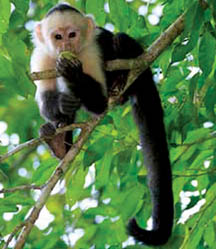
The spider monkeys eat a large quantity of food in a very short
period of time. They search for food while on the move from branch to
branch mostly on suspension (while hanging). Unlike most other primates,
spider monkeys are not in the habit of carrying their food to another
location to be eaten.
Behaviour and births
Spider monkeys live in medium sized, loosely associated groups of
about 30 individuals and the sub-groups are no larger than four
individuals. Females play an active role in the troop. In fact, they are
better than males at planning the day's feeding routes which are highly
economical and differ from day-to-day.
The female gives birth to a single infant once every three years.
They are ready to become mums by the time they are 4-5 years of age and
the baby is born after 226-235 days. The spider monkey's baby is born
black and is dependent on the mother's milk up to two years.

The mothers continuously carry their young who cling to their ventrum
(abdomen). At five months, the babies usually travel about on their
mothers' backs. By this time they have already shed their black fur
coats and started to grow their adult coats. Juveniles of 24-50 months
do not climb on to their mothers' backs, but stay close to them at all
times. They spend most of their time exploring, chasing, grappling and
jumping on others of the same age or even play with adults.
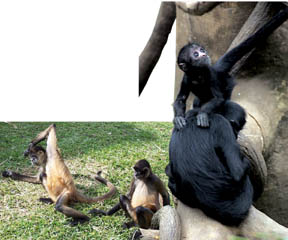
The spider monkeys prefer to live in wet rather than dry forests.
They are diurnal and at night use 'sleeping trees' to rest. They select
tree branches high above the tree canopy which are forked and suitable
for prolonged sleep. When threatened, both genders scare off the
intruders with rough barking and wild behaviour displays. If this fails,
they break into sub-groups and retreat because they dislike getting into
fights.
Both genders sniff and embrace each other when greeting. Males
scent-mark their territory, mixing saliva with a secretion produced from
a gland on the chest. Spider monkeys are not so well groomed.
As the thumbs on their hands are missing, they do not go in for much
grooming as other primates. They scratch themselves using both hands and
feet. They have 'thumbs' on their feet only! |


